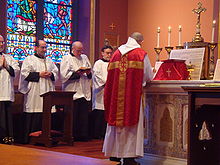Catholic Church
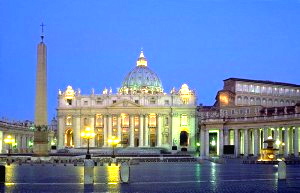
History of Catholicism
In english and with subtitles in english too.
 St. Peter’s Basilica, Vatican City
St. Peter’s Basilica, Vatican City
The Catholic Church, also known as the Roman Catholic Church, is the largest Christian church, with more than 1.16 billion members worldwide. It is among the oldest religious institutions in the world and has played a prominent role in the history of Western civilisation. The Catholic hierarchy is headed by the Pope, the Bishop of Rome. The Church teaches that it is the one true Church founded by Jesus Christ, that its bishops are the successors of Christ’s apostles and that the Pope is the sole successor to Saint Peter who has apostolic primacy.
The Church maintains that the doctrine on faith and morals that it presents as definitive is infallible. There are a variety of doctrinal and theological emphases within the Catholic Church, including the Eastern Catholic Churches and religious communities such as the Jesuits, the Franciscans and the Dominicans.
The Catholic Church is Trinitarian and defines its mission as spreading the Gospel of Jesus Christ, administering the sacraments and exercising charity. Catholic worship is highly liturgical, focusing on the Mass or Divine Liturgy during which the sacrament of the Eucharist is celebrated. The Church teaches that bread and wine used during the Mass become the body and blood of Christ through transubstantiation. The Catholic Church practises closed communion and only baptised members of the Church in a state of grace are ordinarily permitted to receive the Eucharist.
Catholic social teaching emphasises support for the sick, the poor and the afflicted through the corporal works of mercy. The Catholic Church is the largest non-government provider of education and medical services in the world. Catholic spiritual teaching emphasises spread of the Gospel message and growth in spiritual discipline through the spiritual works of mercy.
The Church holds the Blessed Virgin Mary, as mother of Jesus Christ, in special regard and has defined four specific Marian dogmatic teachings, namely her Immaculate Conception without original sin, her status as the Mother of God, her perpetual virginity and her bodily Assumption into Heaven at the end of her earthly life. Numerous Marian devotions are also practised.
Name: Roman Catholic (term) and History of the term “Catholic”
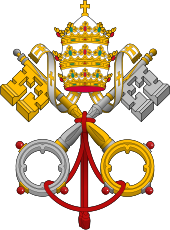 The crossed keys of Saint Peter, a symbol of the Catholic Church
The crossed keys of Saint Peter, a symbol of the Catholic Church
The term “catholic” is derived from the Greek word καθολικός (katholikos) meaning “universal” and was first used to describe the Church in the early 2nd century. The term katholikos is equivalent to καθόλου (katholou), a contraction of the phrase καθ’ ὅλου (kath’ holou) meaning “according to the whole.” “Catholic Church” (he katholike ekklesia) first appears in a letter of St Ignatius written in about 110. In the Catechetical Discourses of St. Cyril of Jerusalem, “Catholic Church” is used to distinguish it from other groups that also call themselves the church.
Since the East–West Schism of 1054, the church that remained in communion with the See of Rome continued to call itself Catholic while the Eastern churches have generally been known as Orthodox or Eastern Orthodox. Following the Protestant Reformation in the 16th century, the Church continued to use the term Catholic to distinguish itself from the various denominations that split off.
The name “Catholic Church” is the most common designation used in official church documents. It is also the term which Pope Paul VI used when signing documents of the Second Vatican Council. However, Church documents produced both by the Holy See and by certain national episcopal conferences occasionally refer to the Roman Catholic Church. The Catechism of Pope Pius X, published in 1908, also used the term “Roman” to distinguish the Catholic Church from other Christian communities who are not in full communion with the Church of Rome.
Organisation and Demographics – The Catholic Church is led by clergy who have received the sacrament of Holy Orders. There are three levels of clergy, the Bishopric, whose members are given geographic area to lead called a diocese or eparchy; the priesthood, who serve the bishops by leading local parishes; and the diaconate, who serve the bishops and priests in a variety of ministerial roles. Ultimately leading the entire church is the Bishop of Rome, called the Pope. In parallel to the diocesan structure are variety of religious orders and institutions that function autonomously within the church, often subject only to the authority of the Pope, though sometimes subject to the local bishop. Religious orders may be open to both male or female members. Additionally, lay members aid many liturgical functions during worship services.
Papacy and Roman Curia
Hierarchy of the Catholic Church – Pope and List of popes
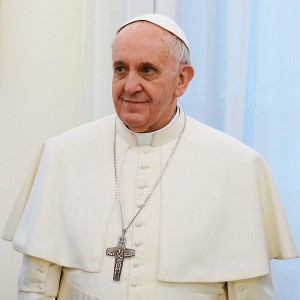 Pope Francis, elected in the papal conclave, 2013
Pope Francis, elected in the papal conclave, 2013
The Church’s hierarchy is headed by the Bishop of Rome, known as the Pope (Latin: papa; “father”), who is the leader of the worldwide Catholic Church composed of the Latin Churchand the Eastern Catholic Churches in full communion with the see of Rome. The current Pope is Francis, elected on 13 March 2013 by papal conclave.
The office of the Pope is known as the Papacy. The Church holds that Christ instituted the Papacy, upon giving the keys of Heaven to Saint Peter. His ecclesiastical jurisdiction is called the “Holy See” (Sancta Sedes in Latin), or the “Apostolic See” (meaning the see of the Apostle Saint Peter). Directly serving the Pope is the Roman Curia, the central governing body that administers the day-to-day business of the Catholic Church. The Pope is also Sovereign ofVatican City State, a city-state entirely enclaved within the city of Rome. The legal entity of the Holy See is distinct from that of the Vatican City state and all foreign relations are accredited to the Holy See.
The position of cardinal is a rank of honour bestowed by popes on certain ecclesiastics, such as leaders within the Roman Curia, bishops serving in major cities and distinguished theologians. For advice and assistance in governing, the pope may turn to the College of Cardinals.
Following the death or resignation of a pope, members of the College of Cardinals who are under age 80 meet in the Sistine Chapel in Rome to elect a successor. Although this election, known as a papal conclave, can theoretically elect any male Catholic as Pope, since 1389 only fellow cardinals have been elevated to that position.
Autonomous Particular Churches – Latin Church and Eastern Catholic Churches
The Catholic Church is made up of 23 autonomous particular churches, each of which accepts the paramountcy of the Bishop of Rome on matters of doctrine. These churches, also known by the Latin term sui iuris churches, are communities of Catholic Christians whose forms of worship reflect different historical and cultural influences rather than differences in doctrine. In general, each sui iuris church is headed by a patriarch or high-ranking bishop, and has a degree of self-governance over the particulars of its internal organisation, liturgical rites, liturgical calendar and other aspects of its spirituality.
The largest of the particular churches is the Latin Church, which reports over one billion members. It developed in southern Europe and North Africa. Then it spread throughout Western, Central and Northern Europe, before expanding to the rest of the world. The Latin Church considered itself to be the oldest and largest branch of Western Christianity, a heritage of certain beliefs and customs originating in various European countries, some of which are shared also by many Christian denominations that trace their origins to the Protestant Reformation.
Relatively small in terms of adherents compared to the Latin Church, but important to the overall structure of the Church, are the 22 self-governing Eastern Catholic Churches with a membership of 17.3 million as of 2010. The Eastern Catholic Churches follow the traditions and spirituality of Eastern Christianity and are composed of Eastern Christians who have always remained in full communion with the Catholic Church or who have chosen to reenter full communion in the centuries following the East–West Schism and earlier divisions. Some Eastern Catholic Churches are governed by a patriarch who is elected by the synod of the bishops of that church, others are headed by a major archbishop, others are under a metropolitan, and others are organised as individual eparchies. The Roman Curia has a specific department, the Congregation for the Oriental Churches, to maintain relations with them.
Dioceses, Parishes and religious Orders
Individual countries, regions, or major cities are served by particular Churches known as dioceses or eparchies, each overseen by a Catholic bishop. Each diocese is united with one of the worldwide “sui iuris” particular churches such as the Latin Church or one of the Eastern Catholic Churches. In 2008, the Catholic Church had 2,795 dioceses. The bishops in a particular country are members of a national or regional episcopal conference.
Dioceses are divided into parishes, each with one or more priests, deacons or lay ecclesial ministers. Parishes are responsible for the day to day celebration of the sacraments and pastoral care of the Catholic laity.
In the liturgy, Catholic men may serve as deacons or priests. Men and women may be equally recognised as altar servers,Extraordinary ministers of Holy Communion or as readers (lectors).
Ordained Catholics, as well as members of the laity, may enter into consecrated life either on an individual basis, as a hermit orconsecrated virgin, or by joining an institute of consecrated life (a religious institute or a secular institute) in which to take vowsconfirming their desire to follow the three evangelical counsels of chastity, poverty and obedience. Examples of institutes of consecrated life are the Benedictines, the Carmelites, the Dominicans, the Franciscans, the Missionaries of Charity and the Sisters of Mercy.
“Religious institutes” is a modern term encompassing both “religious orders” and “religious congregations” which were once distinguished in Canon Law. The terms “Religious order” and “religious institute” tend to be used as synonyms colloquially.
Membership Statistics
 Countries and regions with Catholic majority. Catholicism by country List of Christian denominations by number of members
Countries and regions with Catholic majority. Catholicism by country List of Christian denominations by number of members
Church membership in 2011 was 1.214 billion (17.5% of the world population), an increase from 437 million in 1950 and 654 million in 1970. Since 2010, the rate of increase was 1.5% with a 2.3% increase in Africa and a 0.3% increase in the Americas and Europe. 48.8% of Catholics live in the Americas, 23.5% in Europe, 16.0% in Africa, 10.9% in Asia and 0.8% in Oceania. Catholics represent over half of all Christians.
In 2011, the Church had 413,418 priests. The main growth areas have been Asia and Africa with 39% and 32% increases respectively since 2000. In 2006, members of consecrated life totalled 945,210; 743,200 of whom were female.
Worship and liturgy – Catholic liturgy
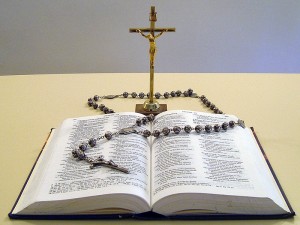 Catholic religious objects— Holy Bible, crucifix and rosary.
Catholic religious objects— Holy Bible, crucifix and rosary.
Among the 23 autonomous (sui iuris) churches, numerous forms of worship and liturgical traditions exist, called “rites”, which reflect historical and cultural diversity rather than differences in belief. In the definition of the Code of Canons of the Eastern Churches, “a rite is the liturgical, theological, spiritual, and disciplinary patrimony, culture and circumstances of history of a distinct people, by which its own manner of living the faith is manifested in each Church sui iuris,” but the term is often limited to liturgical patrimony. The most commonly used liturgy is the Roman Rite in its ordinary form, but other rites are in use in the Eastern Catholic Churches and even in the Latin Church.
Celebration of the Eucharist
In all rites, the Mass or Divine Liturgy is the centre of Catholic worship. The Catholic Church teaches that at each Mass offered by a validly ordained priest the bread and wine become the body and blood of Christ. While all aspects of the bread and wine open to the senses (the appearances or “species”) remain as before, the Church teaches that the underlying reality is transmuted into the body, blood, soul and divinity of Christ, a change that the Church calls transubstantiation, denoting a change that is real, not merely symbolic.
The Catholic Church also teaches that the Mass is a true, propitiatory sacrifice for sin, with the priest offering Christ to God the Father in persona Christi. Thus the elements of bread and wine are consecrated separately, signifying the sacrificial nature of the Mass, as Christ’s blood was separated from his body during the crucifixion.
The words of consecration are drawn from the three synoptic Gospels and a Pauline letter. The Church teaches that Christ established a New Covenant with humanity through the institution of the Eucharist at the Last Supper (considered “the first Mass”) as described in these biblical verses.
Because the Church teaches that Christ is present in the Eucharist, there are strict rules about who may celebrate and who may receive the Eucharist in the Catholic Church. The sacrament can only be validly confected by a validly ordained priest. Those who are conscious of being in a state of mortal sin are forbidden to receive the sacrament until they have received absolution through the sacrament of Reconciliation (Penance). Catholics are normally obliged to abstain from eating for at least an hour before receiving the sacrament.
Catholics, even if they were in danger of death and unable to approach a Catholic minister, may not ask for the sacraments of the Eucharist, penance or anointing of the sick from someone, such as a Protestant minister, who is not known to be validly ordained in line with Catholic teaching on ordination. Likewise, even in grave and pressing need, Catholic ministers may not administer these sacraments to those who do not manifest Catholic faith in the sacrament. In relation to the churches of Eastern Christianity not in communion with the Holy See, the Catholic Church is less restrictive, declaring that “a certain communion in sacris, and so in the Eucharist, given suitable circumstances and the approval of Church authority, is not merely possible but is encouraged.”
Western liturgical Rites
The Roman Rite is the most common rite of worship used by the Catholic Church. Its use is found worldwide, spread by missionary activity originating in European Catholic nations throughout Christian history.
Two forms of the Roman Rite are authorised at present. The generally used ordinary or standard form, celebrated mostly in the vernacular, is that of the post-1969 editions of the Roman Missal, originally promulgated by Pope Paul VI, and is known as the Mass of Paul VI. The 1962 form of the same rite is authorised as an extraordinary form, Celebration of Mass in this usus antiquior (older use) is often referred to as theLatin Mass or Tridentine Mass, the latter name being a reference to its 1570 standardisation by Pope Pius V after the Council of Trent. This was the ordinary form of the Roman-Rite Mass until superseded in 1969 by the Roman Missal of Paul VI. After 1969, its use required permission from bishops; but Pope Benedict XVI‘s 2007 motu proprio Summorum Pontificum allowed free use of the Roman Missalpromulgated by Pope John XXIII in 1962 (the year of the opening of the Second Vatican Council) for Mass celebrated without a congregation and authorised parish priests to permit, under certain conditions, its use even at public Masses. An outline of the major liturgical elements of the Roman-Rite Mass can be found in the side bar.
“Anglican Use” parishes use a variation of the Roman rite that retains some of the wording of the Anglican liturgical rites. 2009 saw the creation of ordinariates for groups of Anglicans who have been approved for entrance into the Catholic Church and who may also use a rite that incorporates elements of Anglican tradition. Other Western liturgical rites (non-Roman) include the Ambrosian Rite and the Mozarabic Rite.
Eastern Liturgical Rites
An Eastern Catholic bishop of the Syro-Malabar Church holding the Mar Thoma Cross which symbolises the heritage and identity of the Saint Thomas Christians of India
The liturgical rites of the Eastern Catholic Churches are very similar to, and often identical with, the rites used by the Eastern Orthodox and other Eastern Christian churches that historically developed in Russia, Caucasus, the Balkans, North Eastern Africa and the Middle East, but are no longer in communion with the Holy See. The Eastern Catholic Churches are either groups of faithful who have restored full communion with the Pope, while preserving their identity as Eastern Christians, or groups with which full communion has never been broken.
The rites used by the Eastern Catholic Churches include the Byzantine Rite, in its Antiochian, Greek and Slavonic varieties, the Alexandrian Rite, the Syriac Rite, the Armenian Rite, the Maronite Rite and the Chaldean Rite. In the past some of the rites used by the Eastern Catholic Churches were subject to some degree of liturgical Latinisation. However, in recent years Eastern Catholic Churches have returned to traditional Eastern practices in accord with the Vatican II decree Orientalium Ecclesiarum. Each church has its own liturgical calendar.
Theology – Catholic theology
The fundamental beliefs of the Christian religion are summarised in the Nicene Creed. For Catholics, they are detailed in theCatechism of the Catholic Church. The Catholic Church holds that it is the One, Holy, Catholic and Apostolic Church. Based on the promises of Christ in the Gospels, the Church believes that it is continually guided by the Holy Spirit—which reveals God‘s truth through Sacred scripture, Sacred tradition and the Magisterium. — and so protected infallibly from falling into doctrinal error.
Sacred Scripture consists of the 73 book Catholic Bible. This is made up of the 46 books found in the ancient Greek version of the Old Testament—known as the Septuagint —and the 27 New Testament writings first found in the Codex Vaticanus Graecus 1209 and li sted in Athanasius‘ Thirty-Ninth Festal Letter. Sacred Tradition consists of those teachings believed by the Church to have been handed down since the time of the Apostles. Sacred Scripture and Sacred Tradition are collectively known as the “deposit of faith” (depositum fidei). These are in turn interpreted by the Magisterium (from magister, Latin for “teacher”), the Church’s teaching authority, which is exercised by the Pope and the College of Bishops in union with the Pope, the bishop of Rome.
Trinity
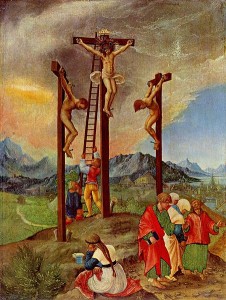 The Crucifixion of Christ featuring Saint Dismas and criminal Gestas by Albrecht Altdorfer, 1526
The Crucifixion of Christ featuring Saint Dismas and criminal Gestas by Albrecht Altdorfer, 1526
The Catholic Church holds that there is one eternal God, who exists as a mutual indwelling of three persons: God the Father; God the Son; and God the Holy Spirit, which make up the Trinity.
Catholics believe that Jesus Christ is the second person of the Trinity, God the Son. In an event known as the Incarnation, through the power of the Holy Spirit, God became united with human nature through the conception of Christ in the womb of the Blessed Virgin Mary. Christ therefore is both fully divine and fully human. It is taught that Christ’s mission on earth included giving people his teachings and providing his example for them to follow as recorded in the four Gospels.
The Church teaches that through the passion (suffering) of Christ and his crucifixion as described in the Gospels, all people have an opportunity for forgiveness and freedom from sin and so can be reconciled to God. The Resurrection of Jesus gained for humans a possible spiritual immortality previously denied to them because of original sin. By reconciling with God and following Christ’s words and deeds, an individual can enter the Kingdom of God, which is the “… reign of God over people’s hearts and lives.”
The Greek term “Christ” and the Hebrew “Messiah” both mean “anointed one”, referring to the Christian belief that Jesus’ death and resurrection are the fulfilment of the Old Testament’s messianic prophecies.


